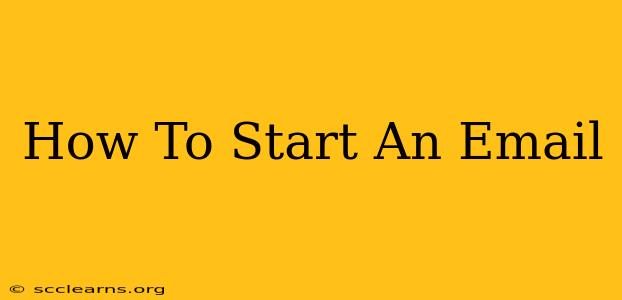Starting an email can feel like walking a tightrope. You need to grab the recipient's attention, set the tone, and establish context, all within the first few words. This guide will help you master the art of the email opener, ensuring your messages are read and responded to.
Understanding Your Audience and Purpose
Before diving into specific opening lines, consider your audience and the purpose of your email. Are you emailing a colleague, a potential client, a friend, or a family member? The appropriate opening will vary drastically depending on your relationship with the recipient and the reason for your email.
Key Considerations:
- Formality: A formal email to a potential client requires a different approach than a casual email to a friend.
- Relationship: Your existing relationship will influence your tone and level of familiarity.
- Purpose: Are you requesting information, making a sale, following up, or simply catching up? The purpose dictates the appropriate opening.
Effective Email Opening Lines: Examples & Strategies
Here are several proven strategies and examples to help you craft compelling email openings:
1. The Direct Approach (For Familiar Contacts & Urgent Matters):
This approach works best for colleagues, clients you know well, or when time is of the essence. Get straight to the point without unnecessary pleasantries.
- Example: "Regarding the project deadline..."
- Example: "Following up on our last conversation..."
- Example: "Quick question about the invoice..."
Why it works: Saves time and demonstrates efficiency.
2. The Personalized Approach (For Building Rapport):
Personalization strengthens connections and shows you've taken the time to consider the recipient. Referencing a shared experience or previous interaction builds rapport.
- Example: "I enjoyed our conversation at the conference about [topic]..."
- Example: "I saw your recent post on [platform] about [topic] and wanted to share my thoughts..."
- Example: "I hope this email finds you well. I was reminded of your expertise on [topic]..."
Why it works: Shows you value their time and have made a genuine effort.
3. The Question Approach (To Spark Engagement):
Starting with a question piques curiosity and encourages a response. Keep it concise and relevant.
- Example: "Are you available for a brief call next week to discuss [topic]?"
- Example: "Have you had a chance to review the proposal I sent?"
- Example: "What are your thoughts on the new marketing campaign?"
Why it works: Encourages interaction and keeps the recipient engaged.
4. The Value-Added Approach (To Highlight Benefits):
Immediately highlight the value or benefit the recipient will receive by reading your email.
- Example: "I've found a solution to the problem you mentioned..."
- Example: "This email contains important updates you need to know..."
- Example: "I'm sharing some valuable resources that might be helpful for [topic]..."
Why it works: Makes the reader eager to learn more.
5. The Contextual Approach (To Set the Stage):
Use a short sentence to quickly provide context or background.
- Example: "Following up on my previous email regarding [topic]..."
- Example: "In response to your query about [topic]..."
- Example: "Regarding the upcoming meeting on [date]..."
Why it works: Sets the stage and ensures the reader is on the same page.
Avoiding Common Mistakes:
- Overly Casual Openings: Avoid informal greetings like "Hey" or "What's up?" in professional contexts.
- Vague Openings: Avoid generic phrases that lack context, like "Hope you're having a great week."
- Long-Winded Openings: Get to the point quickly. Respect the recipient's time.
- Ignoring the Subject Line: Ensure your opening aligns with the subject line.
By thoughtfully crafting your email opening, you significantly increase your chances of engagement and successful communication. Remember to always consider your audience, purpose, and context. Practice these strategies and find the best approach for each unique email you send.

